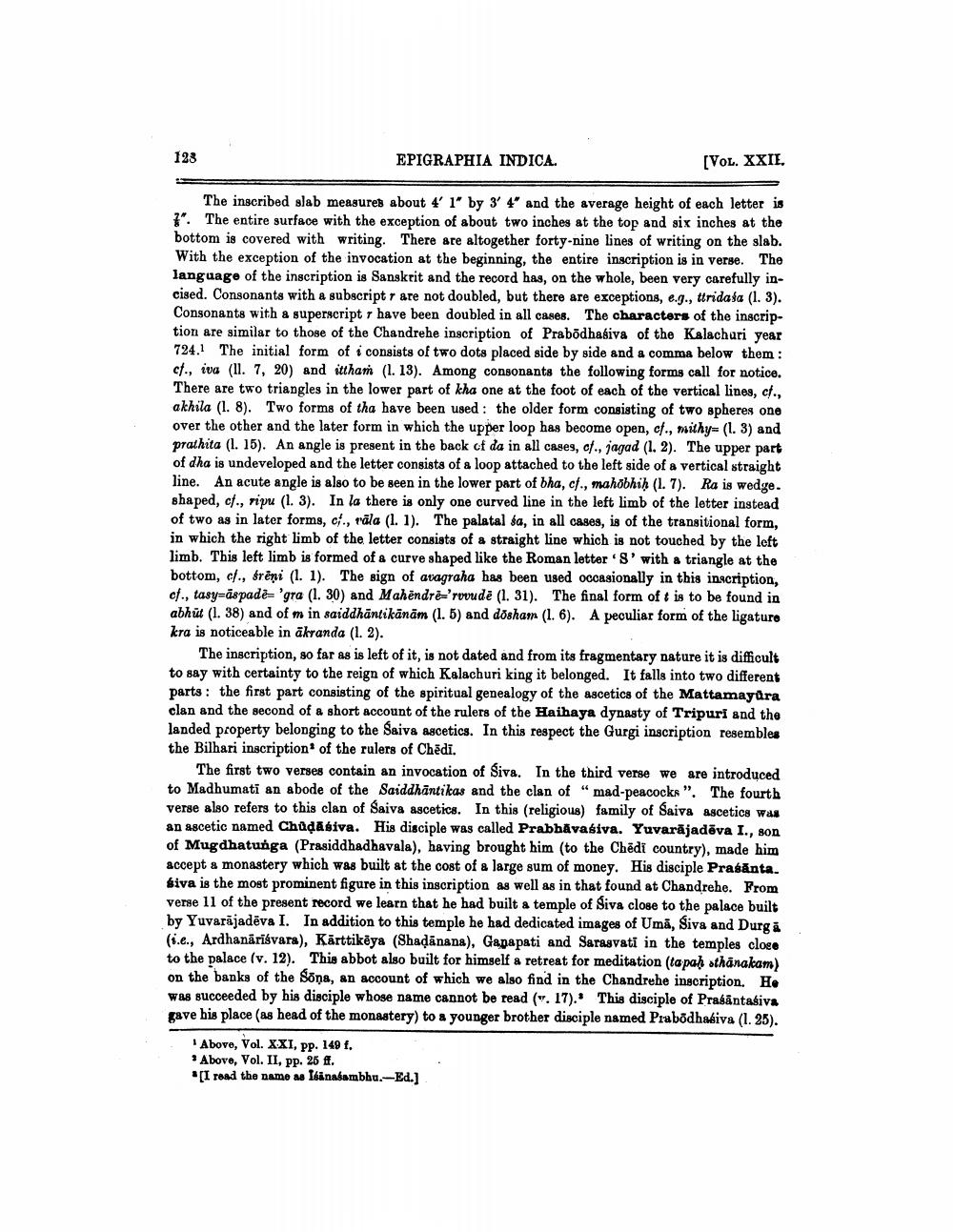________________
123
EPIGRAPHIA INDICA.
(VOL. XXIL.
The inscribed slab measures about 4' 1" by 3' 4" and the average height of each letter is 3". The entire surface with the exception of about two inches at the top and six inches at the bottom is covered with writing. There are altogether forty-nine lines of writing on the slab. With the exception of the invocation at the beginning, the entire inscription is in verse. The language of the inscription is Sanskrit and the record has, on the whole, been very carefully incised. Consonants with a subscript r are not doubled, but there are exceptions, e.g., tiridasa (1.3). Consonants with a superscript have been doubled in all cases. The characters of the inscription are similar to those of the Chandrehe inscription of Prabodhasiva of the Kalachuri year 724. The initial form of i consists of two dots placed side by side and a comma below them : cf., iva (11.7, 20) and ittham (1.13). Among consonants the following forms call for notice. There are two triangles in the lower part of kha one at the foot of each of the vertical lines, ct., akhila (1. 8). Two forms of tha have been used : the older form consisting of two spheres one over the other and the later form in which the upper loop has become open, cf., mithy=(1.3) and prathita (1. 15). An angle is present in the back of da in all cases, cf., jagad (1.2). The upper part of dha is undeveloped and the letter consists of a loop attached to the left side of a vertical straight line. An acute angle is also to be seen in the lower part of bha, cf., mahobhiḥ (1. 7). Ra is wedge. shaped, cf., ripu (1.3). In la there is only one curved line in the left limb of the letter instead of two as in later forms, c., pāla (1. 1). The palatal sa, in all cases, is of the transitional form, in which the right limb of the letter consists of a straight line which is not touched by the left limb. This left limb is formed of a curve shaped like the Roman letter 'S' with a triangle at the bottom, ct., treni (1. 1). The sign of avagraha has been used occasionally in this inscription, cf., tasy=āspade- 'gra (1. 30) and Mahendre='ruvudē (1. 31). The final form oft is to be found in abhūt (1. 38) and of min saiddhāntikānām (1.5) and dosham (1. 6). A peculiar form of the ligaturo kra is noticeable in akranda (1.2).
The inscription, so far as is left of it, is not dated and from its fragmentary nature it is difficult to say with certainty to the reign of which Kalachuri king it belonged. It falls into two different parts: the first part consisting of the spiritual genealogy of the ascetics of the Mattamayura clan and the second of a short account of the rulers of the Haihaya dynasty of Tripuri and the landed property belonging to the Saiva ascetics. In this respect the Gurgi inscription resembles the Bilhari inscription of the rulers of Chēdi.
The first two verses contain an invocation of Siva. In the third verse we are introduced to Madhumati an abode of the Saiddhāntikas and the clan of "mad-peacocks". The fourth verse also refers to this clan of Saiva ascetics. In this (religious) family of Saiva ascetics was an ascetic named Chůdāśiva. His disciple was called Prabhāvasiva. Yuvarājadēva I., son of Mugdhatunga (Prasiddhadhavala), having brought him to the Chēdi country), made him accept a monastery which was built at the cost of a large sum of money. His disciple Praśānta. siva is the most prominent figure in this inscription as well as in that found at Chandrehe. From verse 11 of the present record we learn that he had built a temple of Siva close to the palace built by Yuvarājadëva I. In addition to this temple he had dedicated images of Umā, Siva and Durgå (i.e., Ardhanarisvars), Kärttikėya (Shadānana), Gapapati and Sarasvati in the temples close to the palace (v. 12). This abbot also built for himself a retreat for meditation (tapah sthanakam) on the banks of the Sona, an account of which we also find in the Chandrehe inscription. He was succeeded by his disciple whose name cannot be read (v. 17). This disciple of Prasantasiva gave his place (as head of the monastery) to a younger brother disciple named Prabodhabiva (1.25).
Above, Vol. XXI, pp. 149 f. . Above, Vol. II, pp. 25 ff. *[I read the name as Isinasambbu.-Ed.]




